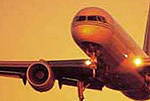Safety Board Calls For Fuel Tank Safety
AP
15-May-2002 11:17 AM U.S. EDT

Reducing the chance of an airplane fuel tank explosion, blamed for destroying TWA Flight 800, remains a top priority for the U.S. National Transportation Safety Board.
Board members, in listing their most-wanted safety improvements on Tuesday, unanimously voted to renew their call for adding nitrogen or another nonflammable gas to fuel tanks.
The board has made the recommendation annually since 1997, the year after TWA Flight 800 exploded after taking off from John F. Kennedy Airport in New York en route to Paris. All 230 people aboard were killed.
The Federal Aviation Administration has ordered new inspections and fuel tank designs, but a joint government-airline industry task force last summer said requiring nonflammable gases would be too expensive, putting the cost of modifying aircraft at $10 billion to $20 billion.
Nevertheless, the FAA has started to test equipment to add noncombustible gases to the fuel tanks.
“The technology is proving more promising than we originally thought,” FAA spokesman Les Dorr said.
The safety board's aviation safety director, John Clark, said the costs of such a system were less than expected.
In addition, the air displaced by the noncombustible gases could become another source of oxygen for passengers, an unexpected cost-saving, Clark said.
Observed safety board chairwoman Marion Blakey: “It does look as though real progress is being made.”
Since its creation in 1967, the board has issued 11,885 recommendations, and 81.6% have been followed.
“We are encouraged by the progress that we have seen in the acceptance rate of our recommendations,” Blakey said. “However, the board will continue to push federal and state government agencies, industry and private companies for more safety improvements to enhance our transportation system for the benefit of all Americans.”
The board's other most-wanted safety improvements for airplanes for 2002 include:
-- Requiring booster seats for children ages 4-8 in cars and child seats for infants and toddlers on airplanes.
-- Developing better systems to detect and remove ice on wings and setting standards to ensure planes can fly after ice forms.
-- Updating regulations on how long pilots and professional drivers can work.
-- Preventing airplanes, vehicles or people from entering airport runways by mistake.
See Also: